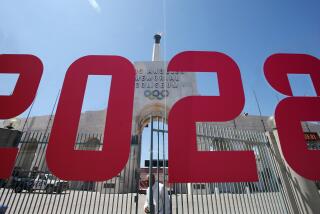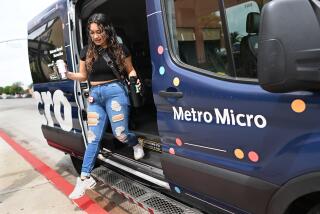RTD Pinched by Soaring Costs of Its Management
While the RTD has been cutting bus service and threatening fare hikes, spending on management salaries and benefits, lobbying, computer systems and other administrative overhead has risen faster than any other area of the transit system’s budget.
A recent independent audit of the Southern California Rapid Transit District and an analysis of spending reports by The Times show that these sorts of administrative costs also have substantially outpaced increases in ridership, as well as spending increases to operate and maintain buses on the streets.
The trend is significant because the more administrative burden RTD carries, the less service it can maintain on the streets. “The overall result of administrative staff growth has been low productivity, measured as (bus) service hours per employee,” concluded one Los Angeles County Transportation Commission audit prepared by Price Waterhouse, the large San Francisco-based consulting firm.
Rise in Costs
Over the last four years, general administrative costs--totaling $108 million in 1986, or about 20% of the budget--have grown 56%, according to figures provided by the RTD.
And a recent outside audit of the RTD by the Transportation Commission found that between 1982 and 1985, expenditures on wages and salaries for the central administration of the bus system grew 54.7%, more than twice the system’s overall increase in costs, after being adjusted for changes in levels of service.
By comparison, expenditures on wages and salaries for bus operators grew only 17%, while vehicle maintenance salaries grew about 25%. Negotiated fringe benefits for managers also grew at a rate higher than other employee groups.
The overall management staff, including those in central administration, bus depots and maintenance facilities, grew about 27% in that period, the auditors found--more than twice the overall employee growth of the district.
Ridership Off 9%
More recent spending figures show that central administrative costs, despite some reductions in expenditures on salaries and wages, grew 10% in 1985-86, continuing to increase at a pace quicker than other major areas of the budget during a time when annual boardings dropped 9%.
The administrative cost increases have been criticized by the Transportation Commission, which controls a large share of RTD’s revenue and under state law is charged with monitoring the district’s efficiency.
“On balance, we believe administrative costs have grown more rapidly than is warranted,” said Jim Sims, director of programming and fiscal analysis for the commission.
Los Angeles County Supervisor Deane Dana, chairman of the commission, said the trend in administrative costs “just gets back to the basic management problem over there. . . . I think (RTD’s management structure) is extremely unwieldy.” Dana recently won approval for the county to conduct a study to determine how RTD and the commission can be reorganized to improve management efficiency.
RTD’s administrative spending also is likely to be an issue in the weeks ahead as RTD Board of Directors members wrestle with yet another round of possible fare hikes or service cutbacks because of an anticipated budget shortfall of $2 million to $6 million. In addition, the board, attempting to rebuild public confidence in the bus system after a rash of accidents and doubts about driver safety, is under pressure to scrape together funds to hire more drivers and improve their training and field supervision.
In interviews, some RTD board members said they were not familiar with the administrative cost figures, although they generally defend management spending and noted that it still is less than half what is spent on bus operations. Some administrative cuts were approved last year and helped achieve a $4-million savings, they said. Those savings were required by the Transportation Commission before it would grant RTD an increase in funds this year.
Checking the Costs
RTD board President Jan Hall said, “I think we have to look at administrative costs to be sure we have been cautious about how those dollars are spent.” But she said critics should bear in mind “the magnitude of the (RTD system) and the kind of operation needed to manage that.”
But board member Nikolas Patsaouras said he believes that “we can still cut a little more fat. At first blush (RTD General Manager John) Dyer will say no . . . (but) if there has to be belt-tightening, I say we can come up with another couple of million” from administration.
Joseph B. Scatchard, RTD’s treasurer-controller and a member of Dyer’s budget committee, said more complex purchasing regulations mandated by the federal government, sharply higher insurance premiums and a new state-of-the-art data-processing program added to administrative costs.
He said planning costs also increased because ridership swelled between 1982 and 1985 when special voter-approved subsidies reduced basic fares to 50 cents.
However, last year’s ridership dropped 9% and this year’s boardings are running below projections.
Costly Office
One of the biggest jumps in administrative costs has been in Dyer’s office--where expenditures last year of $675,000 were nearly three times those in 1982. However, his office expenses were $812,000 in 1984-85.
After coming to the RTD from Miami in 1981, Dyer won approval to expand his personal staff from one to six. Dyer also obtained substantially greater spending for consultants, including Washington lobbyists hired to help secure funding for the proposed Metro Rail subway.
Although Metro Rail expenses generally are budgeted separately from the bus operation, the project has added to the administrative burden borne by the bus system.
Officials said funds for the lobbyists have totaled more than $800,000 in recent years. “Metro Rail is a $3.2-billion project and it needs a lot of attention,” Scatchard said.
The 11-member RTD board also contributes to the bus system’s overhead with travel and meeting expenses that have been running between $80,000 and $100,000 a year. Much of the board’s spending on travel, which reached a high point in 1984, has been related to Metro Rail. Members have taken trips to the Orient and London and other cities to view subway systems. They also have made regular treks to transit conferences and Washington to lobby congressional and administration officials.
“I don’t think it is junkets. I don’t think it is wasteful,” Hall said. “I think it is part of becoming an informed board member. Those trips . . . add to the general knowledge and decision-making capacity of the members of the board.” RISING COSTS AT RTD Until this year, an increase in ridership accompanied RTD’s rising costs of administration, operations and maintenance. But now, with costs still going up--particularly those of administration--ridership is declining. Spending is represented in millions of dollars.
Category of Spending 1981-2 1982-3 1983-4 1984-5 1985-6 General & Admin. Costs $69.2 $77.8 $90.4 $98.0 $108.3 Annual % Increase 12% 16% 8% 10% % Increase Over 4 Years 56% Operation of Buses 197.2 209.1 222.1 246.2 258.3 Annual % Increase 6% 6% 11% 5% % Increase Over 4 Years 31% Bus Maintenance 95.7 105.7 116.0 121.3 129.1 Annual % Increase 10% 10% 5% 6% % Increase Over 4 Years 35% Boardings 354.6 415.9 465.6 497.1 450.3 Annual % Increase 17% 12% 7% -9% % Increase Over 4 Years 27%
More to Read
Sign up for Essential California
The most important California stories and recommendations in your inbox every morning.
You may occasionally receive promotional content from the Los Angeles Times.









